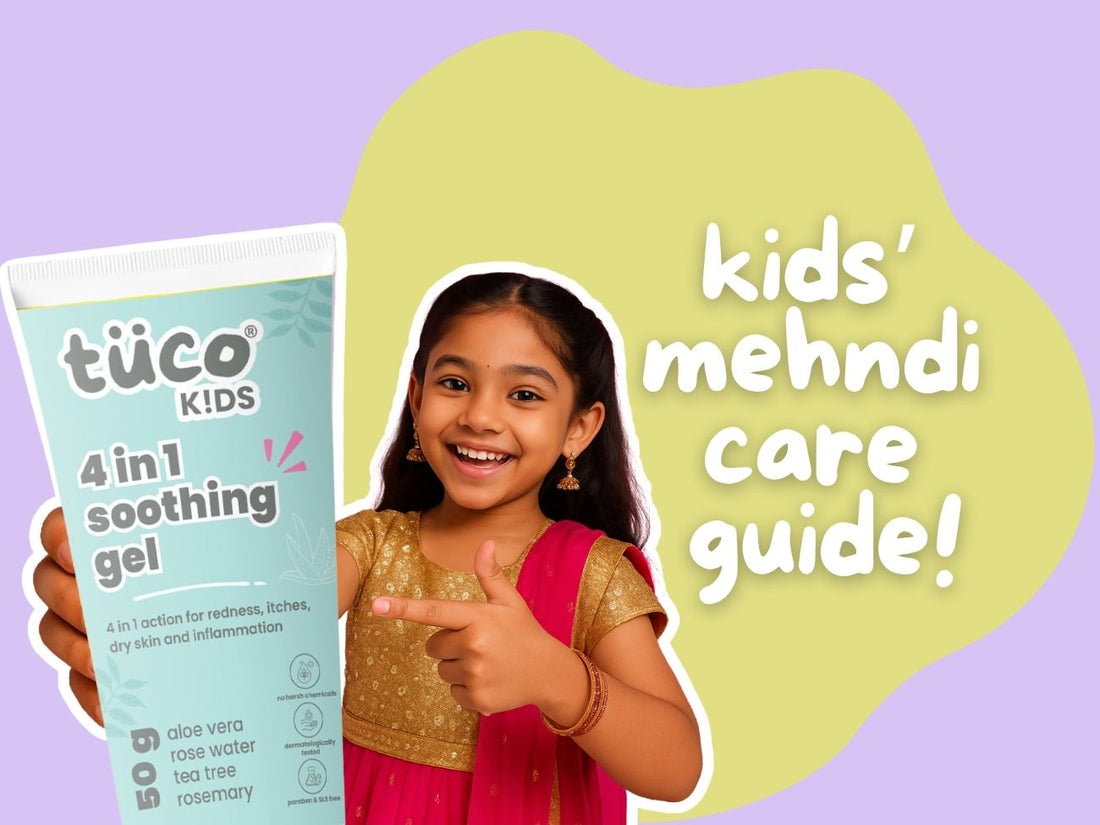
Safe and Natural Mehndi for Kids: What Parents Should Know
Share
Mehndi, or henna, has been a cherished tradition for festivals, weddings, and cultural celebrations for centuries. Kids, too, love the joy of getting their hands adorned with pretty designs. But as parents, it’s natural to wonder: is mehndi safe for children? The answer depends on the type of mehndi being used. Choosing safe, natural mehndi for kids is essential to protect their delicate skin while letting them enjoy the fun.
Why Kids’ Skin Needs Extra Care
Children’s skin is more sensitive and thinner compared to adults, which makes it prone to irritation, dryness, and allergic reactions.
Keep your little one’s skin soft and nourished with Tuco Skin Lotions — gentle, healthy hydration designed especially for kids. Made with safe, non-toxic ingredients, these moisturizers protect delicate skin without harsh chemicals. Check out Tuco Skin Lotions
Their skin also absorbs substances more quickly, so anything applied topically — including mehndi — must be free from harmful chemicals. That’s why chemical-laden cones or “instant color” mehndis are not recommended for kids.
The Risks of Chemical mehndi
Many ready-made mehndi cones available in the market contain additives like:
-
PPD (para-phenylenediamine) – often used in “black mehndi,” which can cause burns, blisters, and permanent scarring.
-
Artificial dyes and preservatives – added to darken color quickly but harsh on kids’ skin.
-
Strong essential oils (like clove or eucalyptus in high amounts) – can irritate young skin.
Exposure to these ingredients can cause itching, rashes, redness, or even long-term allergies in children. A lot of time kids end up with dry skin on the mehndi applied areas. Extra dryness can cause peeling of the upper layer of the skin which can be quite painful for the kids.
What Makes Mehndi Safe and Natural for Kids?
Safe natural mehndi is made from pure, dried henna leaves, sometimes blended with gentle, natural boosters like:
-
Beetroot juice – for a natural red tint.
-
Turmeric – adds warmth and antibacterial protection.
-
Amla (gooseberry) – nourishes and gives a darker shade safely.
-
Rose water – for mixing, making the paste soothing and fragrant.
Such formulations are toxin-free, non-irritating, and safe for kids’ delicate skin. Parents can make these formulations at home also by mixing the desired ingredient and keeping it covered overnight.
Tips for Parents When Choosing Mehndi for Kids
With so many mehndi cones and powders available in the market, it can be difficult for parents to know which ones are truly natural and safe.
-
Check the label carefully – Look for 100% natural henna with no chemicals or artificial dyes. Safe natural mehndi should list henna (Lawsonia inermis) as the main ingredient, sometimes mixed with lemon juice, sugar, or mild essential oils.
If the cone mentions PPD, dyes, artificial colors, parabens, or preservatives, avoid it completely for kids.
-
Avoid “black mehndi” completely – It almost always contains PPD, which is unsafe for children. If the paste looks jet black or very dark brown straight out of the cone, it is usually mixed with synthetic dyes (like PPD). These are unsafe for kids.
-
Supervise the drying time – Prevent kids from licking, scratching, or smudging fresh mehndi.
-
Moisturize after washing off – Apply a gentle kids’ lotion or oil to prevent dryness.
-
Look at the Color and Texture of the Paste – Fresh natural henna paste has a greenish-brown or olive green tone. Once applied, it leaves a reddish-brown stain that darkens over 24–48 hours. Chemical-laden paste may feel overly sticky, too runny, or unnaturally smooth (like synthetic gel). This is a red flag.
-
Check the Smell – Natural mehndi has a distinct earthy, grassy smell because it is made from ground henna leaves. Sometimes, a hint of essential oil like eucalyptus or tea tree may be added — but the fragrance should still feel mild and natural.
Chemical mehndi often has a strong, pungent, or chemical-like odor. If it smells artificial or overwhelming, it’s best avoided for children.
-
Do a patch test – Apply a small amount on the inside of the wrist and wait 24 hours to rule out allergies.
- Go for smaller, simple designs – Kids can’t sit for long, so opt for tiny flowers, stars, or cartoon motifs.
-
Natural Henna Brands Available in the Market: Options include Khadi Herbal Nut Brown Henna (for a soft brown tone), We Herbal Natural Henna Powder (pure, chemical-free for homemade pastes), Banjara’s Natural Henna (budget-friendly), and Khadi Henna & Hibiscus Powder (with hibiscus for added conditioning).
From What Age Is Mehndi Safe?
Natural mehndi can be safely applied to kids from around age 3 onwards, provided it is free from chemicals and applied in small amounts. For toddlers, it’s best to avoid mehndi, since their skin is extremely delicate and they may rub it into their mouth or eyes and ingest it.
For parents who want only the best for their little ones, Tuco Kids provides a complete range of healthy, nourishing care, from gentle skin moisturizers and body lotions to safe shampoos, hair oils, and bathing bars. Made with toxin-free, child-friendly formulas, Tuco Kids products protect delicate skin and hair without harsh chemicals. Give your kids the safe, everyday care they deserve with Tuco Kids. Discover the full range for growing children' s skin needs today.
Safe natural mehndi for kids is all about keeping the tradition fun without compromising skin health. Parents should always choose pure, chemical-free mehndi, do a patch test, and stick to simple, quick designs. By taking these precautions, you can let your little ones enjoy the magic of mehndi safely and beautifully during every festival and celebration.

